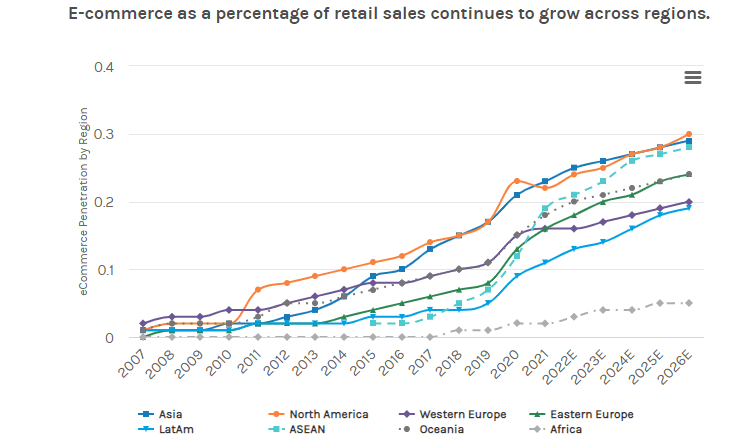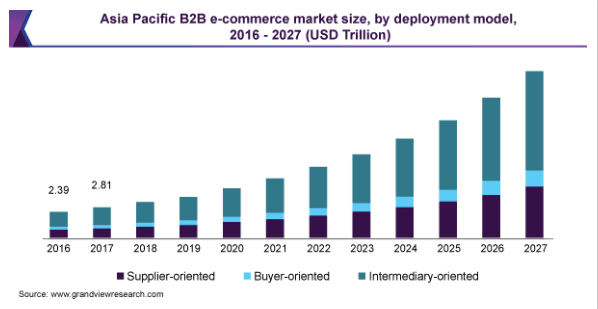The online eCommerce market today has vastly grabbed the attention of businesses across the globe. Simply, because of the high demand and convenience, it drives buyers, who are just a tap away from exploring the wide arsenal of the eCommerce landscape.
Over the years, eCommerce development solutions have encountered a boom in the Internet, reaching a value of US $13 Trillion in 2021. This is huge for not just sellers but also IT companies who are helping vendors to expand their reach and allow audiences to know more about the product and services at their fingertips. How exciting is that?
In this article, we are going to highlight the future scope of the eCommerce industry by discussing its market overview and scalable growth exponentially. So, let’s get started!
The eCommerce industry– Introduction
The connective eCommerce or electronic commerce industry has widely revolutionized and evolved the way people use to buy and sell products or even connect with shop owners. Today, you can simply go to the eCommerce website and get whatever you want whenever just by scrolling through your mobile phone. Listening to an ecommerce podcast offers valuable insights to enhance your online business.
From customization to enhancing return policies and improved integration, the changes have taken the world of eCommerce software development by storm. And 2022 is no exception, let’s find the market trends of the retail market for this year and beyond in the below segment.
Email validation is integral to the future success of the eCommerce industry. It not only addresses immediate concerns like deliverability and bounce rates but also contributes to long-term customer relationships, regulatory compliance, and the overall efficiency of marketing efforts.
The Global Trends of eCommerce in 2022 & Beyond
1. Online sales growth is unstoppable

Till now, we have been replicating the boom of the retail market and we are going to mention once again that eCommerce sales have seen a scalable slope of a mountain and for good intention.
Online shopping is one of the most in-demand activities on the internet which is projected to increase 12.2% year-over-year to $5.7 trillion in 2022. What’s more, digital sales is expected to continue expanding and hit $8.1 trillion by the end of 2026– around 55.8% more than that of the overall retail sales previously calculated in 2021.
As per experts, online retail sales are unstoppable. The reason is, the growing population and technological upliftment are always going to increase each year.
2. The evolving role of social media in eCommerce
Additionally, the number of social shoppers is growing quickly. The “Buy” button on Facebook and Instagram Checkout has made social media a big player in the e-commerce industry.
Social media has altered many aspects of our everyday life, including how we shop. This is an excellent time for businesses to consider how to strengthen their social media presence, which is a terrific way for them to be found. Because users are spending more time on social media, e-commerce development companies may benefit from the assistance of Instagram influencers to improve their chances of being found by their target market.
Additionally, companies can simply connect their online storefronts with social media platforms like Shopify so that customers can make purchases from them directly through social media. For instance, Facebook and Instagram frequently update their features to accommodate online shoppers’ comfort requirements.
3. Augmented reality transforms how we shop
Over 120,000 retailers will employ augmented reality (AR) technologies by 2022, providing customers with a far better shopping experience (PRNewswire, 2018). Retail personnel and online consumers will be the ones to promote AR adoption in the industry. The inability to physically hold the merchandise is one of the biggest worries individuals have while purchasing online. Online buyers can more easily picture the things they are interested in thanks to augmented reality (AR) technology, which helps close this gap.
This may completely shift the game for internet shoppers. AR experiences have the potential to alter how internet shoppers view the goods they want to purchase. Customers will be able to better understand their wants and determine if the things they intend to buy satisfy them with the use of augmented reality (AR). A few e-commerce companies have already begun experimenting with augmented reality, which will make them stand out from the crowd. Online purchasing will be improved by giving customers more tailored experiences. Enterprise software development company is utilizing augmented reality (AR) to improve the customer experience as well as provide customers the chance to try and explore items much as they would in a physical store.
4. Personalization is the future
In keeping with the trend towards customization and enhancing the customer experience, adding a printing on demand service can significantly boost your eCommerce business. It allows for personalization that today’s online shoppers desire, making it an excellent addition to any e-commerce strategy.
Custom eCommerce apps are embracing this trend and putting money into personalization strategies to enhance the convenience of online buying. This can entail tailoring email messages sent to specific recipients or giving the appropriate information to a certain customer group. A better shopping experience may be delivered by supplying individualized customer communications, giving out pertinent discounts, and connecting with consumers through, for example, video material. This will assist to develop the relationship with your customers.
The Global eCommerce market: Overview
The size of the worldwide e-commerce industry, which was estimated at USD 9.09 trillion in 2019, is anticipated to increase at a CAGR of 14.7% from 2020 to 2027. The global population of smartphone users is growing as internet usage becomes more widespread.
Among the many e-commerce business development possibilities accessible to the client base that uses the internet more often are financial services, e-tailing, travel and leisure, digital content, and travel. Consequently, it is anticipated that consumer technical knowledge would have a favourable effect on the market expansion. The need for speedier surfing has increased connection, which has sped up the development of 4G and 5G technologies.
What’s more, the IMARC Group projects that the market will grow at a CAGR of 27.4% between 2022 and 2027, reaching US$ 55.6 trillion. We are constantly monitoring and assessing the direct as well as indirect impact of the pandemic on various end-use sectors while keeping in mind the COVID-19 uncertainties. These observations are cited in the study as a significant market contributor.
The Growth of the eCommerce Industry: Conclusion
- From $5.7 trillion in 2022 to $8.1 trillion in 2026, e-commerce revenues are expected to grow.
- Ecommerce penetration rates are anticipated to rise from 22% in 2022 to 27% in 2026.
- Sales of mobile commerce will reach $3.79 trillion by 2022.
- The trend toward internet buying is being led by young people. 67 percent of people have increased their internet spending since the outbreak.
- The number of social shoppers will increase thanks to eCommerce services offered by Facebook, Instagram, and TikTok.
- Green consumerism is expanding. Consumers’ decisions to buy from a firm are reportedly influenced by environmental concerns 30% of the time.
- 57 percent of customers said they would be willing to make their first purchase from an independent, new firm.
These were our take on providing you with the ultimate future scope of the eCommerce industry by including all the latest trends, market analysis, and examining the growth scale of the industry. Having an eCommerce website development company for your business is escalating, if you haven’t paved the way into the digital landscape, now is the time to begin!
Get in touch with a mobile app development company to understand how to start and enter the market of retail seamlessly.











Leave a Comment
Your email address will not be published. Required fields are marked *